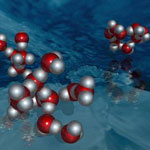New Research Puts Theory of Water Structure on Thin Ice
summary written by Raven Hanna
Water has unusual and complex properties that make it especially well suited to support life. Its macroscopic properties, like surface tension, solubility, and high melting and boiling temperatures, must come from its molecular properties. Although water is all around us, is essential for life, and is a small, simple molecule, we still do not understand how it behaves on a molecular level. We think of water as a fairly regular array of hydrogen-bonded molecules, where each oxygen bonds with a hydrogen on two other molecules. Since each water molecule can bond to four other water molecules, an ordered, tetrahedral symmetry can arise. This hydrogen bonding pattern has been assumed to account for water's special properties.
Using data obtained at SSRL Beam Lines 4-2 and 6-2 and at SPring-8 in Japan a research group led by Anders Nilsson from SLAC has made discoveries that challenge the current models of water behavior. The team used small angle x-ray scattering (SAXS, BL4-2), which can give structural information about non-crystalline materials, to measure inhomogeneities in the density of water at various temperatures. They saw fluctuations in terms of low density regions on a 1nm scale that correspond to the ordered, tetrahedral model described above, but the majority of molecules were found in higher density regions. The structure and states of the molecules in these areas was found through x-ray emission spectroscopy (XES) and x-ray Raman spectroscopy (XRS, BL6-2), techniques that analyze the electronic states of molecules. The researchers found that the molecules in the high density areas were forming asymmetrical, disordered structures, a sort of chaos in which floated some islands of tetrahedral order. Since the ratio of low to high density areas slightly decreased as the temperature increased from 4°C to 90°C, the researchers hypothesize that the water structure was finding a balance between minimizing enthalpy (through extensive hydrogen bonding in the low density structure) and maximizing entropy (the disorder of the high density structure).
This field has been hotly debated in the last few years. If accepted, the new model is a revolution in our perception of water structure. Time - and more experiments - will tell. This research was published in August by the journal Proceedings of the National Academy of Science.
To learn more about this research see the full Scientific Highlight
C. Huang, K. T. Wikfeldt, T. Tokushima, D. Nordlund, Y. Harada, U. Bergmann, M. Niebuhr, T. M. Weiss, Y. Horikawa, M. Leetmaa, M. P. Ljungberg, O. Takahashi, A. Lenz, L. Ojamae, A. P. Lyubartsev, S. Shin, L. G. M. Pettersson and A. Nilsson, "The Inhomogeneous Structure of Water at Ambient Conditions", Proc. Natl. Acad. Sci. USA 106, 15241 (2009) doi: 10.1073/pnas.0904743106


